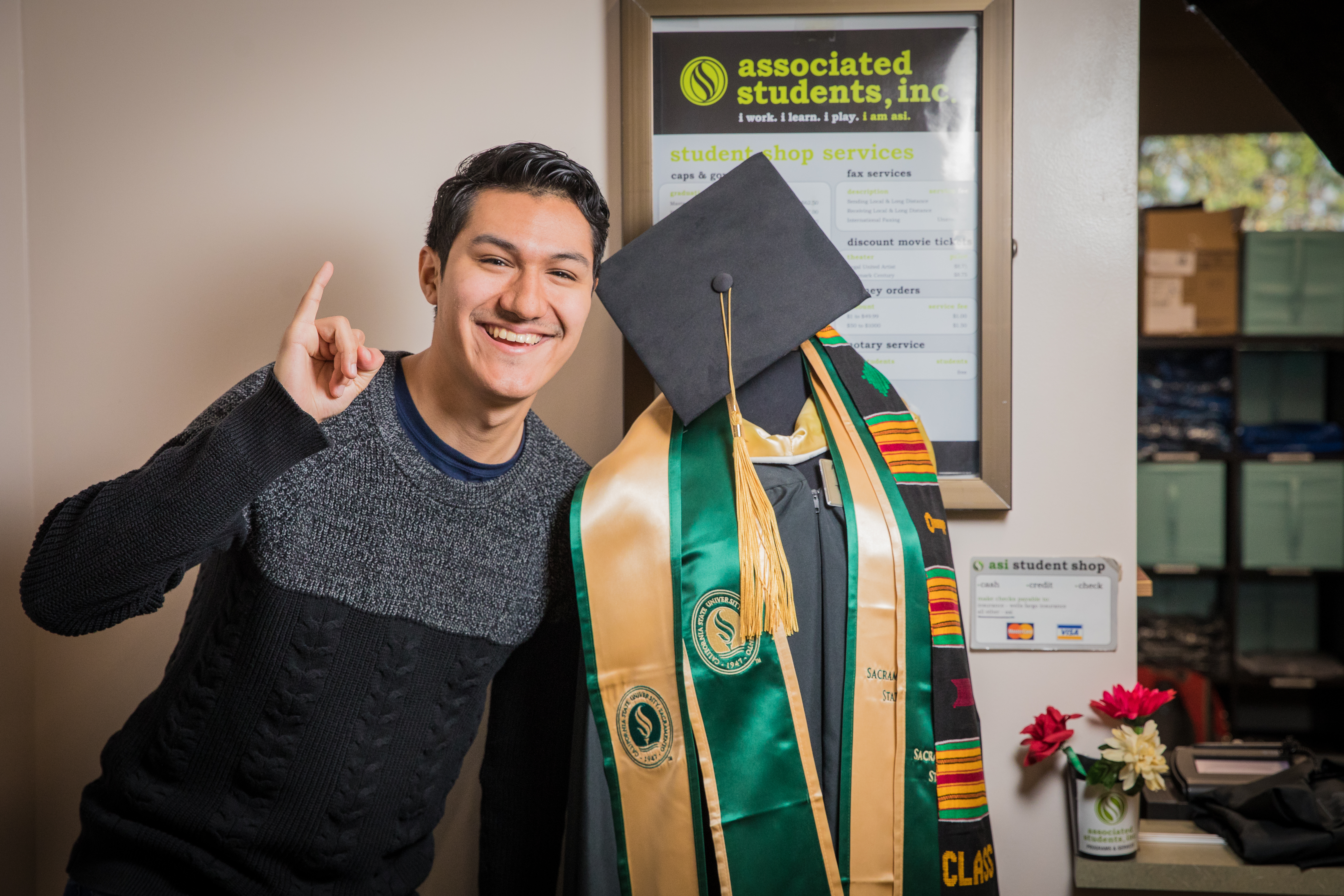 ASI President Noel Mora shows off regalia to be worn by the next batch of Sac State grads. For hundreds, that regalia will come as a gift recognizing their "Finish In Four" efforts. (Sacramento State/Andrea Price)
ASI President Noel Mora shows off regalia to be worn by the next batch of Sac State grads. For hundreds, that regalia will come as a gift recognizing their "Finish In Four" efforts. (Sacramento State/Andrea Price)It was a modest proposal from Sacramento State's graduation czar, Jim Dragna, to a specific group of seniors on campus:
Meet with your advisor to explore ways to more quickly graduate, and the University will pay for your cap, gown and tassel.
"What better incentive than to get your regalia – a symbol of your blood, sweat and tears?" Dragna reasoned.
RELATED: Graduation initiative earns national honor
He directed his message in the fall to 872 seniors who had compiled 126 or more credits in a single major and had fulfilled other requirements but had yet to graduate. He thought he'd give them an extra push to finish their degrees this spring or summer as part of the University's innovative effort to reduce the time it takes to get to the finish line.
Dragna figured that perhaps a few dozen students would take him up on his offer to meet with a faculty or graduate advisor. By early December, 240 had done so.
They have huddled with their advisors to determine whether adding credit hours, focusing on completing more courses in their major areas of study, or making other changes to their academic schedules might help pave the way toward graduation this spring or summer. In exchange for the meetings they receive a voucher for their reglalia, which typically costs $37.
"Something as simple as this can be an effective way of moving people forward," said Dragna. "And when students change that trajectory here, we believe they can change it for their entire families."
Dragna's office, University Initiatives and Student Success, is at the forefront of Sac State's "Finish in Four" and "Through in Two" programs, part of an effort that aims to increase the number of incoming freshman and transfer students earning bachelor's degrees in four years. Those programs were a response to California State University's Graduation Initiative 2025, a system-wide push to boost on-time grad rates.
Sac State's program, launched in the summer of 2016, already has earned national recognition. In October, President Robert S. Nelsen traveled to Washington, D.C., to accept a prestigious award from the American Association of State Colleges and Universities for strategies designed to increase graduation rates and reduce achievement gaps.
As part of the campaign, participating students each pledge to take at least 15 units every semester and in turn receive academic and administrative support: Small grants, and the addition of 12,000 new classroom seats, new faculty members, and hundreds of new course selections that are offered based on student demand are in place to support Finish In Four/Through In Two.
In the fall of 2016, 37 percent of first-year students took 15 or more units during their first semester. This year, that number jumped to 72 percent. The four-year graduation rate has risen from about 8 percent in 2016 to nearly 15 percent last year, the highest it has been in three decades.
By staying the course, the University hopes to raise that rate to 30 percent by 2025. Dragna thinks the University can do even better.
"We should be somewhere in the 40 percent range," based on the performances of universities similar to Sacramento State, he said. "We're changing the culture. Before, all of the effort went into getting into the University. Now, it's about finishing."
The regalia incentive is one example of how the University is encouraging more students to reach that goal.
Associated Students Inc. (ASI) President Noel Mora said the cap-and-gown gift resonates powerfully.
In addition to offering students a small financial break, "it makes the idea of graduation more real," he said. "It helps students visualize the home stretch, the final days. It's an image to pair with the overall goal."
Mora, who finished his undergraduate degree in political science in May and is working on a master's in public policy administration, said he was somewhat skeptical when he first heard about "Finish in Four." He wondered whether the initiative would be backed by significant resources or if it would have a tangible impact. Now, he is a believer.
"At the heart of it, it is telling students, 'Yes, you can do this. Yes, we believe in you.' " Mora said. "Our dreams and our hopes are being validated. These are not just words. There is action behind the promises. As a student leader, it's something that makes me very proud of our school." – Cynthia Hubert
